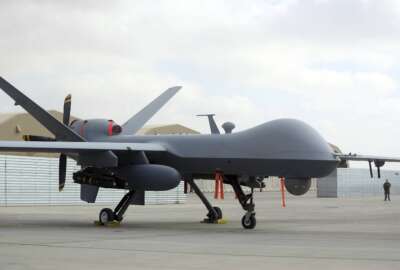Hicks presses Congress to increase support for Replicator, RDER
"Take Replicator," Hicks said. "We’ve done nearly 40 Hill briefings since last October. That depth of engagement isn’t scalable for Congress."
Deputy Secretary of Defense Kathleen Hicks on Wednesday sent a pointed message to Congress at the NDIA emerging technologies conference, saying that congressional trust will “need to substantially expand” when it comes to the department’s innovation programs.
“Take Replicator,” Hicks said. “We’ve done nearly 40 Hill briefings since last October, averaging almost one a week.”
“On an initiative that represents 0.059 percent of DoD’s budget — that depth of engagement isn’t scalable for Congress across the breadth of what we’re all trying to accomplish.”
Replicator, unveiled last August, is Hicks’ key initiative to quickly field thousands of all-domain, attritable autonomous systems by August 2025.
Hicks said the military is already operating Replicator’s attritable autonomous systems in real time across multiple regions worldwide. In addition, the first military units have completed new equipment training with Replicator systems.
“We’ve learned valuable lessons about ways to use ADA2 systems that we didn’t even consider at first,” Hicks said.
“For instance, the Navy is experimenting with and demonstrating their uncrewed surface vessels for missions like persistent maritime domain awareness, environmental monitoring, logistics resupply, and humanitarian assistance and disaster relief — like rescuing people who fell overboard at sea, or delivering food and supplies to otherwise inaccessible island communities in the wake of a typhoon — so you don’t have to use or divert a crewed vessel to do those things.”
The Defense Department has been tight-lipped about the capabilities selected for the first tranche of Replicator, but it has announced the purchase of Switchblade 600 kamikaze drones developed by AeroVironment.
This lack of information might lead to skepticism and doubts about whether DoD has properly assessed the capabilities and costs associated with the initiative, according to the recent Congressional report.
Hicks, however, defended the initiative by laying out what the Defense Department has done to support the program.
“We created a process to review and strengthen the cybersecurity of companies that support Replicator before we publicize specific systems or vendor names,” Hicks said. “We launched multiple Commercial Solutions Openings to diversify the vendor base for things like uncrewed surface vehicles and other ADA2 capabilities. Over 550 hardware and software companies have sent submissions to Replicator-related CSOs — some don’t even know they’re about Replicator.”
“We’ve also obligated both research and development and procurement dollars, totaling in the nine figures already, to a range of traditional defense industry and non-traditional companies — including venture-backed start-ups, growth-stage companies, and larger DoD contractors.”
The Defense Department secured about $500 million for the initiative in 2024 and requested the same amount for fiscal 2025.
In their version of the 2025 defense spending bill, Senate appropriators recommended that Congress fully funds the initiative.
In addition, since the DoD is already working on a second tranche of systems for the Replicator, Senate appropriators said it might seek additional funding from Congress to be able to meet the deadline to field thousands of ADA2 systems by August 2025. Appropriators’ recommendation was to slow the rate of growth requested for another innovation program dubbed the Rapid Defense Experimentation Reserve and move some of those funds to the Replicator initiative.
“The intent of this reallocation is to enable the Department of Defense to reassess the RDER concept and provide the Committee additional information on the most effective use of requested funds for fiscal year 2025, which may include continuing RDER efforts or accelerating Replicator Tranche Two systems until such time as funds for these systems can be aligned in the appropriate appropriations accounts in future budget submissions,” Senate appropriators said.
Hicks pushed back and said the department needs initiatives like RDER since it served as a foundation for multiple innovation programs, including Replicator.
“We need just as much help from Congress in ensuring joint experimentation can enable delivery of effective capabilities to the warfighter. From Replicator’s success to combatant command priorities like the Joint Fires Network, we need efforts like RDER that bring rigor to our discernment of what is and isn’t ready to scale. For instance, because of RDER’s successful transitions to programs of record, the Marine Corps’ Family of Integrated Targeting Cells for joint fires was accelerated by five years,” Hicks said.
“We will keep burning shoe leather to build trust with Congress, from Rayburn hallways to
Dirksen elevators. We know oversight is vital to our democracy. At the same time, trust is a two-way street.”
Copyright © 2025 Federal News Network. All rights reserved. This website is not intended for users located within the European Economic Area.






